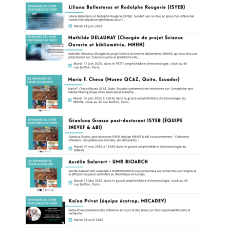Claudia HEMP (coordinator of the research unit Kili-SES)


Les séminaires de l’ISYEB accueilleront Claudia HEMP (coordinator of the research unit Kili-SES) actuellement en visite SYNTHESYS+ au Muséum nous présentera ses travaux :
Mountainous East Africa is known for its high degree of biodiversity and endemism, especially along the so-called Eastern Arc Mountains, stretching through Tanzania and southern Kenya. The Eastern Arcs were ranked under the ten most important hotspots for endemism. These mountain ranges harbour evergreen rainforests due to the westward winds that continuously bring moisture from the Indian Ocean. Geologically young volcanoes adjacent to the northern branch of the Eastern Arc chain, such as Mount Kilimanjaro or Mount Meru, were thrown up in connection with the uplift of the rift valley system about 1–2Ma. Recent surveys focusing on the Orthoptera fauna show that these mountains also harbour a high biodiversity and a high degree of endemism in orthopteran insects. Forest expansion during humid periods and retraction during dry periods are the best explanation for the patterns of geographical species distribution found on east African mountains. Vegetation corridors along rivers must have favoured the dispersal of coastal taxa into the hinterland along the east African coast. During dry and warm periods taxa which became trapped in montane habitats successively adapted to the montane climate or went extinct. The special arrangement of mountain chains probably facilitated speciation. We suggest that climate fluctuations and orogenesis rather than a long lasting and stable climate – in difference to the current scientific opinion - are most likely the reason for the high diversity found on the Eastern Arc Mountains and inland volcanoes. We also suggest that these speciation processes are limited to 1–2Ma and cannot be explained with the old geological age of the Eastern Arc chain. Flightless and habitat-restricted Orthoptera serve as ideal model organisms to illuminate mechanisms of speciation.



